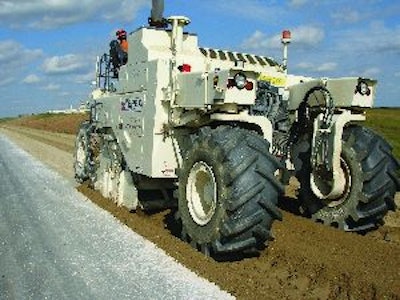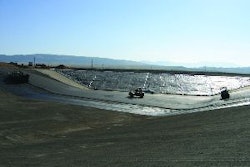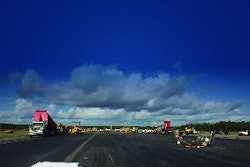
When Lanny Schottle first got into the niche field of bituminous pavement reclamation, he had just one Terex CMI RS650 reclaimer/stabilizer for his projects primarily in the state of North Dakota. Within just four years, business had grown to the point where he had purchased two more units, including a larger RS800 with a 10-ft. head.
Today, Road Reclaimers of St. Cloud, MN, has three RS800s with 8-ft. heads, and works primarily in Minnesota, though it still tackles jobs in North and South Dakota. Schottle chose to switch entirely to the larger machines due to the unique conditions encountered on roads in the Upper Midwest.
Bigger proves to be better
As Road Reclaimers expanded both its business and market territory, Schottle quickly realized he needed more power from his machines. "Some of the roads we run into, the asphalt is 10 to 12 in. thick. We have to grind all the asphalt and the gravel below it," he says. "When we got into 10 to 11 in. of asphalt, we didn't have hardly enough power to get through it."
Consequently, Schottle switched over to the larger RS800s. "Many times, when we go down a county road, we'll hit a culvert crossing where it's always settling... and they will keep patching it and patching it," he notes. "When you're going along the road with this big machine, at least you have enough power to get through that area, and then you can get back up to speed and the production again."
The RS800 reclaimer/stabilizer comes with a standard 8-ft.-wide by 50-in.-diameter mandrel incorporating 218 tungsten carbide teeth. Its cutting width is 96 in., with cutting depths to 16 in. A heavy, unitized mainframe with center-mounted 800-hp engine and cutter distribute the machine's 67,500-lb. weight and horsepower over the cutter head for greater productivity. A direct V-belt-driven, four-speed rotor transmission provides optimum cutter torque to match conditions.
Bi-directional travel allows the operator to match working direction and cutter speed range for optimum gradation and blending control. Four-wheel steering and four-wheel drive let the operator select from coordinated steering, crab steering or steering of either leading pairs of wheels.
A cut above
The combination of these features has proven highly effective on Road Reclaimers' projects. Schottle cites a job last summer near Two Harbors, MN, on County Road 2, which once served as a logging road.
"Average asphalt thickness was anywhere from 11 1/2 to 6 in. It varied as we went along," he explains. "When we hit the 11 in., with a smaller machine or less horsepower, I think we would have been stopped dead and would have had to regroup. With the RS800s, we went through the 11 in. It may have been at a slower pace, but we got through it."




















